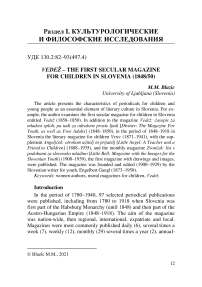Vedez - the first secular magazine for children in Slovenia (1848/50)
Автор: Blazic M.M.
Журнал: Социальные и гуманитарные науки: теория и практика @journal-shs-tp
Рубрика: Культурологические и философские исследования
Статья в выпуске: 1 (5), 2021 года.
Бесплатный доступ
The article presents the characteristics of periodicals for children and young people as an essential element of literary culture in Slovenia. For example, the author examines the first secular magazine for children in Slovenia entitled Vedez (1858-1850). In addition to the magazine Vedez: casopis za mladost sploh, pa tudi za odrasene proste ljudi [Diviner: The Magazine For Youth, as well as Free Adults] (1848-1850), in the period of 1848-1918 in Slovenia the literary magazine for children Vrtec (1871-1941), with the supplement Angeljcek: otrokom ucitelj in prijatelj [Little Angel: A Teacher and a Friend to Children] (1888-1935), and the monthly magazine Zvoncek: list s podobami za slovensko mladino [Little Bell: Magazine with the Images for the Slovenian Youth] (1900-1939), the first magazine with drawings and images, were published. The magazine was founded and edited (1900-1929) by the Slovenian writer for youth, Engelbert Gangl (1873-1950).
Women authors, moral magazines for children, vedez
Короткий адрес: https://sciup.org/147236866
IDR: 147236866 | УДК: 130.2:82-93(497.4)
Текст научной статьи Vedez - the first secular magazine for children in Slovenia (1848/50)
In the period of 1780–1940, 97 selected periodical publications were published, including from 1780 to 1918 when Slovenia was first part of the Habsburg Monarchy (until 1848) and then part of the Austro-Hungarian Empire (1848–1918). The aim of the magazine was nation-wide, then regional, international, expatriate and local. Magazines were most commonly published daily (6), several times a week (7), weekly (12), monthly (29) several times a year (2), annual-
ly (13), while some were published in other manner or there is not sufficient data on the matter.
In the period of 1780–1799 two magazines were published: Lai-bacher Zeitung [1] (1778–1918) in German and the literary almanac Pisanice [2] (1779–1781) in Slovenian, both in Ljubljana. Laibacher Zeitung was the biggest and most influential daily magazine in German language in the Slovenian territory. In 1804, they began issuing the supplement Wochenblatt zum Nutzen und Vergnugen , which was renamed Illyrisches Blatt [3] in 1818 (1819–1849), altogether publishing 8,191 volumes. The aim of the newspaper was the dissemination of general knowledge. Illyrisches Blatt was the central cultural magazine (theater, literature, history) in Slovenian region, including the participation of the greatest Slovenian intellectuals, for example Matija Čop (1797–1835), Miha Kastelic (1796–1868), Franc Malavašič (1818–1863) and Janez Bleiweis (1808–1881). The newspaper is fully accessible in digital form at the National and University Library in Ljubljana and the Europeana . The publisher was Ignaz Alojz Edler von Kleinmayr (1745–1802) from the family of publishers Kleinmayr. In the 123-year history of Laibacher Zeitung (1778– 1918) 24,912 magazines were published.
The poetry almanac Pisanice od lepeh umetnosti [ Easter Eggs of Fine Arts ] was published from 1779–1781, however, only two printed volumes and an additional one – the third, handwritten volume – were actually published; the editor was the priest Feliks Anton Dev (1732–1786). Pisanice included the participation of some of the most prominent Slovene members of the Enlightenment, the priest Marko Pohlin (1735–1801) and the poet Valentin Vodnik (1758–1819).
Most of the magazines which were published in the Slovenian language (74 of 97) were aimed at the general reader profiles, of which only 9 were literary magazines ( Slovenske večernice , 1860 (Celje), Cvetje iz domačih in tujih logov, 1861–1868 (Celovec), Mladika (1868–1868 Ljubljana), Slovenska Talija (1868–1896, Ljubljana), Zabavna knjižnica (1886–1913, Ljubljana), Slovenska knjižnica (1893–1913, Gorica), Anton Knezova knjižnica (1894– 1918, Ljubljana), Prevodi iz svetovne književnosti (1904–1955, Ljubljana) and Modra ptica (1929–1944, Ljubljana).
Tanja Žigon wrote about the German newspapers in the Slovenian region (Ljubljana; Dolenjska, Styria, Klagenfurt and Graz), high- 13
lighting Laibacher Zeitung , Carniola and other German newspapers which were published in Ljubljana [4, s. 9–11].
Moral weeklies
First Slovene weekly, Lublanske novice, 1797–1800
The first Slovenian weekly – Lublanske novice [ Ljubljana News ] (1797–1800) – was published for four years, during which time 277 volumes were published. The weekly magazine was created on the initiative of the important member of the Enlightenment, Žiga Zois (1747–1819). The main poet, Valentin Vodnik (1758–1819), was a writer, translator and editor. Initially, the newspaper was published in hundreds of copies and had 33 subscribers. The weekly followed the example of Wiener Zeitung (1703), while conceptually it was based on the concept of Enlightenment and Slovene national movement. The weekly has published the current educational and entertainment content in the field of economy, culture and entertainment.
Kmetijske in rokodelske novice, 1843–1902
The Slovenian newspaper Kmetijske in rokodelske novice [ Agricultural and Craft News ] was published during the period of 1843– 1902 and was originally published on a weekly basis (1843–1852), later twice a week (1852–1857), then again once a week (1857– 1902). In the period of 1843–1881 the main editor was Janez Bleiweis (1808–1881). Bleiweis was a practical man and a veterinarian by profession, so many contributions consisted of practical advice for farmers and craftsmen. The weekly also published articles in the field of culture and literature. Most of its readers were farmers, craftsmen and priests, i.e. the all-Slovenian public. Beside Bleiweis’, the magazine also published contributions by others, for example, by Matija Majar (1809–1892) in the field of folk literature. Kmetijske in rokodelske novice (1843–1902) were the leading magazine in the field of culture and politics, exerting a major impact on national movement and the Slovenian language, literature and culture, as most of the today's Slovenia was under the Habsburg Monarchy (until 1848), then becoming a part of the Austria-Hungary (1848–1918).
National poet France Prešeren
In 1844, the greatest Slovenian poet, France Prešeren (1800– 1849), published the epic poem The Baptism at the Savica in the newspaper, followed in 1848 by the poem A Toast which from 1989 serves as the text of the Slovenian national anthem. Collaborators of the Kmetijske and rokodelske novice were the then most prominent poets, writers, for example Fran Levstik (1831–1887), Janez Trdina (1830–1905), Simon Jenko (1835–1869), Matija Valjavec (1831– 1897), and Josip Jurčič (1844–1881). The Novice (1864) was the shorter, popular name for Kmetijske in rokodelske novice.
Young addressees
In the period of 1848–1900, the religious periodical miscellany Drobtinice [ Crumbs ] was published intermittently. It was founded by the later editor, Bishop Anton Martin Slomšek (1848–1863, Graz; 1863–1869, Drobtinice (editor Bishop Anton Martin Slomšek, Mari-bor); 1887–1900, Drobtinice (editor Frančišek Lampe). The content of Drobtinice which became known under the folcloristic name Slomšek’s Drobtinice was highly educational, with religious content, at the same time serving as a school textbook. The miscellany was published annually, it was very popular and even though it was intended as a "lesson and entertainment for youth" it was also read by adult readers. Very important was the pedagogical work of Slomšek and the reader Blaže in Nežica v nedeljski šoli [ Blaže and Nežica in Sunday School ], 1842. Slomšek was inspired by the examples of the German Christopher Schmid (1768–1854). The reader/textbook Blaže in Nežica v nedeljski šoli contains extensive instructive and practical content. The reader is divided into 52 chapters, such as Kol-ikor jezikov zna, tolikor ljudi velja [ The More Languages One Knows the More He/She Is Worth ] , Ljubo doma, kdor ga ima [ Home Sweet Home ] , Ogenj, potrebna pa nevarna reč [ Fire, a Necessary But Dangerous Thing ], etc.
Women authors
In 1848–1849, the first Slovenian-Austrian female author, Fany Hausmann (1818–1853), published poems Vojaka izhod [ The Soldier’s Leave ] etc., also love poems, in the newspaper Celjske slov-enske novine [ Slovene Newspaper of Celje ] (1848–1849). It is important that women authors also started publishing in the newspaper, for example, Josipina Turnograjska with Donava [ Danube ] (1858), Klara R. with Oda kavi [ Ode to Coffee ] (1864), Marjačič with Miro-slavu odgovor [ Answer to Miroslav ] (1864), the latter including ele- 15
ments of feminism stating that if a man can choose his wife so a woman (the poet) can choose her husband; Ivanka K. with Svoji do-movini [ To My Homeland ] (1865). The most prominent female poet was Luiza Pesjak (1828–1898) who also began to publish in Novice , beginning with Aforizmi [ Aphorisms ] (1864–1865), the poems Roža [ A Flower ] (1864), Cvetice [ Flowers ] (1866), as well as articles on the emancipation Žensko življenje in ženska ljubezen [ The Life and Love of a Woman ] (1865), the play Svitoslav Zajček: Vesela igra v enem dejanji [ The Bunny Svitoslav: A Comedy in One Act ] (1865). She also wrote and/or translated the fairytale Rudeča kapica [ Little Red Riding Hood ] (1875), while later she published the poetry collection Vijolice, pesmi za mladost [ Violets, Poems for the Youth ], 1889. The authors contributed a new sensibility (emotional topics, lyricism), new subject matter (family), new themes ( Oda kavi ) and new genres (fairy tales), as well as new addressees (children and youth). In addition to these authors, after 1862 also others started to publish.
Ode to Coffee
[...]
"I am also pleased to say: coffee, be a sister to me, to you, dear, I shall resort, with you, one can live in peace" [5, s. 32].
A response to Miroslav
"Novice brought
The joke of
How carefully your
Wife you did choose.
[…]
If a man can choose, why can‘t I? […]" [5, s. 33].
In 1852, upon entering of Slovenian woman poets in literary space and the Slovenska Čbela [ Slovenian Bee ] newspaper, Radoslav Razlag (1826–1880) in the Zora [ Dawn ] magazin also used the allusion of "bees", regarding the poems as "honey", the literary space as "bee house", and their writing as "flying".
This year, in "Slov. Bčela" three bees have emerged: from Turno-grad in Carniola, from Ljubljana, and from Ptuj, who willingly distribute sweet honey from their supplies . The first is: Josipina Turnograjska Urbančič, a broadly educated and enthusiastic Slavic prophetess whose writings, the children of a clear mind and sharp pen, we read with great enthusiasm again and again. [...] The second one is A.O. (Vekoslava Bolakova?), who flew from Ljubljana in the bee house of the young "Bčela" [...] The third one, "Ljudmila", barely 14 years old and full of hope, is J.L.G....kova, who flew from Ptuj, the old town on the Styrian planes, in order to bring honey from the land that for a long time now sighs in foreign chains [6, s. 43– 44]. It is also important that the newspaper had a section entitled Priporočilo novih bukev za mladost [ Recommendation of New Books for the Youth ] (1849), in which various books were recommended to young addressees for further reading.
Recommendation of New Books for the Youth
The praiseworthy idea of Mr. Lerher, bookseller in Ljubljana, was to have given books of the famous Jais translated into Slovenian language, entitled "Zgodbe in povesti polne lepih naukov za otroke, pa tudi za odrasle ljudi" ["Stories and Tales Full of Beautiful Lessons for Children as well as Adults"]. Praiseworthy is also the Slovenian language of Mr Cegnar, well known to the readers of Novice , who translated the books from German. We may therefore recommend them to the Slovenian youth with a clear conscience, especially as school gifts. These books were already printed 26 times in the German language; hopefully, they will also win over everyone in the Slovenian translation and that a reprint will soon be required. Also, the printer has done a good job, as 2 volumes bound in book form only cost 20 kreutzers . In addition to quality they are therefore also distinguished by a low price [7].
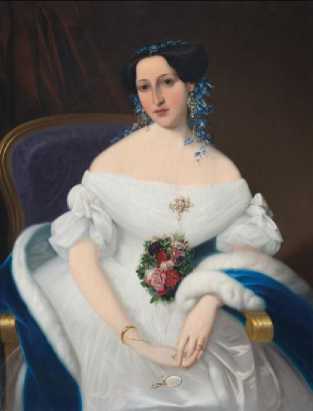
Fig. 1. Luiza Crobath Pesjak (1828–1898) 1
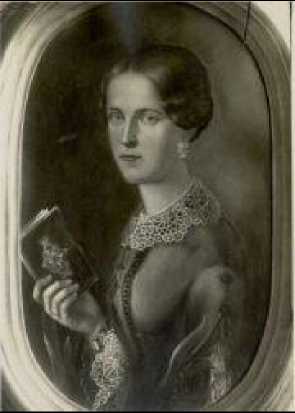
Fig. 2. Josipina Turnograjska Toman (1833–1854) 2
Sprotuletna violica, 1846
The local weekly of national importance was the handwritten student newspaper Sprotuletna vijolica . The newspaper consisted of 4 pages, with 5 written copies and 30 published volumes. The students of the classical gymnasium in Maribor wrote poems in Slovenian. The participators were Ivan Ertl, Miha Golob, Ivan Kocmut, Dragotin Polič and Luka Hleb.
Vedež magazine, 1848–1850
From 1778 to 1848, before the magazine started to be published, Slovenian youth literature began to emerge under German influence. Blaž Kumerdej (1738–1805) translated in 1796 the Vadenje za brati in vse sorte pisanja za šolarje teh deželnih šol v cesarskih kraljevih
-
1 Luiza Crobath Pesjak (1828–1898). Narodna galerija. URL: http://www.ng-slo.si/si/stalna-zbirka/1820-1870/luiza-pesjak-rojena-crobath-mihael-stroj?workId=1707 (accessed: 03.06.2017).
-
2 Josipina Turnograjska Toman (1833–1854). URL:
deželah [ Tutoring for Reading and Writing of All Sorts of Pupils of These Provincial Schools in Imperial Royal Lands ]. Joachim Heinrich Campe (1746–1818) translated Robinzon mlajši: knjižica pre-dragi slovenski mladosti za uk in kratek čas [ Robinson the Younger: Booklet for the Learning and Enjoyment of the Beloved Slovenian Youth ], 1849. The biggest impact in the Slovenian territory was achieved by Christoph von Schmid (1768–1854), with books Prijet-ne pripovedi za otroke [ Pleasant Stories for Children ], 1832, and Kratkočasne pravlice otrokom v učenje [Diverting Fairy Tales for the Learning of Children], 1835. Between 1819–1918 around 100 books by C. Schmid were translated and reprinted in Slovene lanuage. At the time around 1850, the population of the city of Ljubljana counted 17,256, while the alleged number of sold copies of the Vedež weekly magazine counted up to 500.
Publisher Rozalija Eger (1787–1871)
One of her biggest merits is the publishing of the Vedež magazine which contributed to the development of Slovenian youth literature, with the subsequent emergence of the first monthly literary magazine Vrtec [ Nursery School ] (1871–1945), as well as the supplement of the Vrtec magazine – Angeljček: otrokom učitelj in prijatelj [ Little Angel: A Teacher and a Friend to Children ] (1887–1934), and the magazine Zvonček: list s podobami za slovensko mladino [ Little Bell: Magazine with the Images for the Slovenian Youth ] (1900–1939). The important role of Rozalija Eger who powered the development of Slovenian youth literature with the Vedež magazine (1848–1850) was researched by Anja Dular who stated that she was an important Ljubljana printmaker who was not known enough [8].
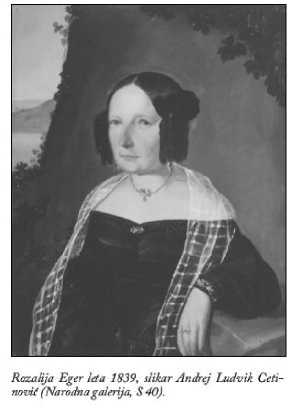
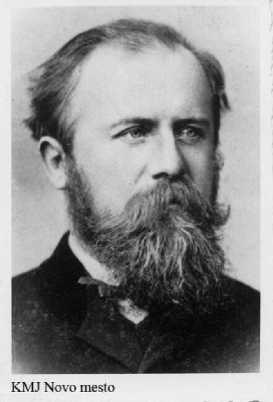
Fig. 3. Rozalija Eger (1788–1871) 3
Fig. 4. Ivan Navratil (1825–1896) 4
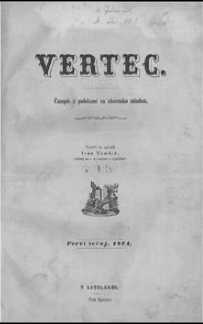
Fig. 5. Vertec 5

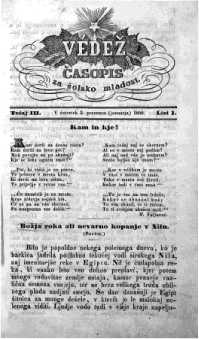
Fig. 6. Vedež: časopis za mladost sploh, pa še tudi za odrašene proste lju-di, 1848
Fig. 7. Vedež: časopis za šolsko mladost, 1949
Fig. 8. Vedež: časopis za šolsko mladost, 1850
Content of the Vedež magazine (1848, 1849, 1850)
The Vedež magazine was a pan-Slovenian magazine, although it was published in the capital city of Ljubljana. Its target audience were young people and adults as the subtitle of the first year, 1848, was Vedež: časopis za mladost sploh , pa tudi za odraščene proste ljudi [ Vedež, The Magazine for Youth, as well as Free Adults ]. From mid-year of 1849 to the end of the magazine’s publishing in 1850 the subtitle has changed to Vedež: časopis za šolsko mladost [ Vedež: Newspaper for Pupils ]. Editor in chief of the Vedež magazine for 1848–1850 was Ivan Navratil, who at the time of editing was 23–25 years old. The importance of the magazine was enormous, as beside the young editor other young authors also published in the magazine (Valjavec, Svetec Podgorski, Praprotnik Detomil, Tomšič et al.). Interestingly, the first mentioned in the magazine was Rozalija Eger, woman publisher – the editor therefore considered the female form of the noun – while in the second place his name was written, Ivan
Navratil. It is interesting that in the second half of the year 1849 the syntagma ‘editor in chief’ appeared. The Vedež magazine was published once a week, while in three years altogether 134 volumes were published, each volume with 8 pages. As the number of subscribers (pupils of all primary schools in Ljubljana) has decreased (it is assumed that the circulation counted 300–500 copies), he in 1851 intended to publish the magazine twice a month himself, but did not receive enough support.
In the first year, 1848, 28 volumes were published (counting 8 pages each), in the second year, 1849, 53 volumes (8 pages each), in the third year, 1850, 53 volumes with 8 pages each. Thus, in the period of 1848–1850 altogether 134 volumes with 8 pages each were published, for the total of 1,072 pages. Notwithstanding the fact that in the Vedež magazine secular content prevailed, the share of moralizing was present throughout, including the literary units (fables, poems, stories, translations, adaptations, funny stories, puzzles). From the content, it is obvious that the Vedež magazine was also a school textbook – for young people and adults. The magazine is fully digitized and is available in the Digital Library of Slovenia at www.dlib.si [10].
Table 1. Table of publishing of Vedež
|
Year |
Volumes |
Number of pages per volume (8/volume) |
Religious content – number of units |
Secular content – fiction |
Total units |
|
1848 |
28 |
224 |
135 |
210 |
597 |
|
1849 |
53 |
424 |
221 |
420 |
1118 |
|
1850 |
53 |
424 |
408 |
440 |
1325 |
|
134 |
1072 |
764 |
1070 |
3040 |
Findings
During the three years of publishing, in 1848, 1849 and 1850, 134 volumes of the magazine were published, together contributing 1,834 titles, of which 1,070 or 58 % were fiction and 42 % had instructive content.
Based on the analysis of the content in the Vedež magazine the subtitle of the magazine was highlighted, reading Vedež: revija za 23
mladost in sploh odrašene ljudi [ Vedež: The Magazine for Youth and Adults ] (1848), as the general section for dual addressees prevailed -young people and adults ( Povesti in zgodbe [ Tales and Stories ], 19% ; Razni spisi [ Various Writings ], 17 %; Nenavadne besede [ Unusual Words ], 10%; Basni [ Fables ], 8 %; Uganke [ Riddles ], 7 %; Smešnice [ Funny Stories ], 7 % ), followed by Pesmi [ Poems ], 6 %; Z ivljenje imenitnih Slovanov [ Lives of Eminent Slavs ], 4 %; discussions between students, as well as descriptions of animals and historical themes.
Funny Story
A poor farmer carried some wheat to the city on his donkey. He just fell behind a bit, as the donkey began braying or howling. Two gentlemen who went along the road toward the farmer said to the latter contemptuously: "Do you not hear the donkey calling you?" The farmer replied: "That is not true; he only laughs of joy because he met two brothers of his" [11].
In the middle of 1849, the subtitle was amended to Vedež: za šolsko mladost [ Vedež: for Pupils ] which was justified by the increase in educational ( Različni poduki in spisi iz zgodovine slovans-ke, domače šege, znamenite reči naše domovine [ Various Lessons and Essays in the History of Slavic, Domestic Customs, the Famous Things of Our Homeland] - 20 %) and school content ( Povesti in zgodbe v poduk [ Tales and Stories Serving as a Lesson ] - 20%), while Pesmi [ Poems ], with 10 %, were less numerous, and there were also funny stories ( Smešnice in kratkočasnice [ Funny and Amusing Stories ] - 9 %); Uganke [ Riddles ] - 7 %; Basni in prilike [ Parables and Fables ] - 6 %; Popisi zivali in povesti od zivali (s podobo) [ Inventory of Animals and Tales of Animals (With Images) ], conversations and explanations of unknown words), as well as a new section - folk literature ( Vraze in prazne vere [ Superstitions and False Religions ]), biographies of important people, and Modri izreki [ Wise Sayings ]. The biggest novelty besides the increasing educational content were the illustrations called podobe [ images ]. Editor Ivan Navratil often encouraged readers to subscribe to the magazine as this would mean more money "for an odd image or two" (illustration) [12].
Flags of Home
Farmer sees every time, the Emperor rarely, but God never [13].
A typical example is the poem by Matija Valjavec entitled Deček pod drevesom [ A Boy Under a Tree ], where the boy talks to a personalized tree that through symbolism of seasons moralises on the meaning of maturation and aging.
A Boy Under a Tree
“In the garden stands a tree, And under it there is a young child. He directs his pure glance toward the tree, Together with his gaze he lifts his head. Thus, he quietly observes the tree, Entranced, he stands below it silently. Suddenly, a voice is heard from the tree, And the hairs on the boy’s head stand upright: [...]
Pick up such treasures now
That shall lead you to heavenly paradise." The voice now stops and falls silent, And baby just keeps standing below it. He takes to his heart the lesson of the voice, And goes home with a moved heart” [14].
In the third year,1850, published under the subtitle Vedež: časopis za šolsko mladost [Vedež: Newspaper for Pupils], the share of educational content increased significantly (Različni poduki in drugi spisi (s podobo) [Various Lessons and Other Writings (With Images)] – 21 %; Povesti, pripovedke in zgodbe [Novels, Tales and Stories] – 14 %; Slovnica kratka slovenskega jezika [A Short Grammar of the Slovenian Language] – 13 %. Then followed the Smešnice in krat-kočasnice [Funny and Amusing Stories] – 10 %, and a new category entitled Naravopisje in naravoznanstvo (s podobo) [Descriptions of Nature and Natural Sciences (With Images)] – 10 %, as well as other sections). The novelty, besides the increasing educational content (mathematics – 4%, natural sciences – 4 %), was also the develop- ment of general literacy (Izgledi pisem [Various Forms of Letters] – 4 %); practical-use orientation (Kmetijstvo in obrtništvo [Agriculture and Crafts] – 5 %), while illustrations were still called podobe [images] in the third, last year.
We shall be happy to print poems that will be worth anything in Vedež . But do not despair, if you do not get lucky already the first time – possibly the second, third. The poems, however, can be sent to us unsigned, without names or, according to the established tradition, under a false name, or only signed by the first letter of the actual name. In the end, we need to remind everyone that the poems should be innocent and appropriate even for the pupils of lower grades. Editorial Board [15].
Список литературы Vedez - the first secular magazine for children in Slovenia (1848/50)
- Laibacher Zeitung. Ignaz Alois Edler v. Kleinmayr, 01.01.1784. URL: http://www.dlib.si/?URN=URN:NBN:SI:DOC-QX2KYDIF (accessed: 04.06.2021).
- Dev, Feliks Anton. Skupspravlanje Kraynskeh pissaniz od lepeh umestnost. Stiskane per Joan. Frideriku Egerju..., 1779-1781. URL:http://www.dlib.si/?URN=URN:NBN:SI:DOC-NPESRLEH (accessed: 04.06.2021).
- Illyrisches Blatt. Kleinmayr, 01.01.1819. URL: http://www.dlib.si/? URN=URN:NBN:SI:DOC-CCMJMPC5 (accessed: 04.06.2021).
- Zigon T. Nemsko casopisje na Slovenskem. Ljubljana: Studenska Zalozba, 2001. 101 s.
- Novak Popov I. Antologija slovenskih pesnic (1825-1941). Ljubljana: Tuma, 2004. Vol. 1. 190 s.
- Lah I. Josipina Turnograjska. s.n., 1921. URL: http://www.dlib.si/? URN=URN:NBN:SI:DOC-EP3GV6XS (accessed: 01.09.2012).
- Priporocilo novih bukev za mladost. Kmetijske in rokodelske novice, year 7. Vol. 29 (18.07.1849). URL: http://www.dlib.si/?URN= URN:NBN:SI:DOC-SFG368KO (accessed: 01.09.2015).
- Dular A. Rozalija Eger - pomembna, a premalo znana ljubljanska tiskarka. Kronika (Ljubljana), year 57. 2009. Special vol. P. 401-412.
- Vedez. Rozalija Eger, 1848. URL: https://www.dlib.si/?URN=URN: NBN:SI:doc-W4JVONDE (accessed: 04.06.2017).
- Vedez magazine. Digital Library of Slovenia. URL: http://dlib.si/results/?euapi=1&query=%27keywords%3dvede%c5%b e%27&pageSize=25&language=eng&sortDir=ASC&sort=date&ftype =%c4%8dasopisje&frelation=Vede%c5%be+(1848) (accessed: 04.06.2017).
- Vedez. Rozalija Eger, 1848. URL: http://www.dlib.si/?URN= URN:NBN:SI:DOC-4FCZDISF (accessed: 01.09.2021).
- Vedez. Rozalija Eger, 1849. URL: https://www.dlib.si/?URN= URN:NBN:SI:doc-W2IGAXJO (accessed: 01.09.2021).
- Vedez. Rozalija Eger, 1849. URL: https://www.dlib.si/?URN= URN:NBN:SI:doc-6W2M4NRC (accessed: 01.09.2021).
- Vedez. Rozalija Eger, 1849. URL: https://www.dlib.si/?URN= URN:NBN:SI:DOC-QIPYP59A (accessed: 01.09.2021).
- Vedez. Rozalija Eger, 1850. URL: http://www.dlib.si/?URN= URN:NBN:SI:DOC-HJNW2EDU (accessed: 01.09.2021).

